You can use the more secure ssl protocol to read these pages: https://www.sunorbit.net
![]() (zur deutschen Version hier klicken)
(zur deutschen Version hier klicken)
If there would have been any further need for a proof of the contents of this site Tau Ceti now delivered the all important proof: this star, which is only 12 light years away from us has been the target of one of the earliest searches for extraterrestrial life in the 60ths and 70ths, but astronomers couldn't find any hints of orbiting planets in the 60s through 90s. A shortly completed re-examination, which especially considered the wobbling of the central star discovered five potential planets ranging from two to nearly seven times the mass of Earth, with orbits ranging from 14 to 640 Earth days long.
But the most exciting fact about this news is, that this discovery was made by purely reanalysing the old data, no new data was won. And mathematics hasn't changed a bit since the sixtieth of last century. Only the new knowledge about wobbling stars led to the discovery of these exoplanets. Two of these planets could potentially be the closest habitable exoplanets yet discovered. So we will likely see soon many new discoveries on many more earlier examined stars.
More info here: http://www.newscientist.com/article/dn23021-nearby-tau-ceti-may-host-two-planets-suited-to-life.html?cmpid=RSS|NSNS|2012-GLOBAL|astrobiology
![]()
Visitors to this site come from all countries in this world as the two logs below show (under .com and .net you find companies of the whole world, the extremely low visitor count from japan may be due to actual problems (atom disaster) in japan, Australia is in these logs underrepresented.compared to other logs). An extremely low visitor count on weekends (esp.sundays: 700 page views typically, compared to 5000-8000 hits on weekdays, this means 2000-3000 page views on weekdays) is an indicator of mostly professional visitors (search engines etc. not counted!). Btw this means more than 2 mio hits per year! Again search engines, archives etc not counted. And since this site is cached in many provider/proxy/etc. caches world wide (which is evident by the cache updates of big providers/proxies etc) you can multiply these numbers by the count of big providers and other caches world wide.
Head hunters should note the enormous intellectual potential of the ancient soviet republic.
Under "unknown domain" you find mostly people which visit this site with anonymising proxies (scientific institutions which don't want to be listed etc..). With ixquick you have even the option to visit all internet pages per proxy!
And then: nearly 70% of the visitors to this site bookmark this site! And revisit this site regularely to see whats new. And an incredible 50% load down the whole site with massdownloaders (perhaps I should offer a downloadable pdf...).
While the normal visitor count rather steadily increases the visitor count from european and US- universities nearly doubles every month in the end of 2011.
On some days up to 20% of all visitors come from universities (there are very few sites in the net with that many visitors from universities. And in this case most of the european universities are even not counted ):

![]()
and a rather constant amount of US-military personal visits these pages nearly every other day and notes every little change (modern military eqipment is very sensitive to particles from solar storms!):
![]()
UC Berkeley's A. Filipenko presented in the history channel documentary: "The Universe: Mars The new evidence" the here first postulated hypothesis "Mars lost his moon(s)" as the latest - although still quite controversial - theory on the history of mars. And since this site presents a coherent theory it is not possible to take just one part of the theory proposed here. So it is likely that this is the first step of acceptance of this theory in whole.

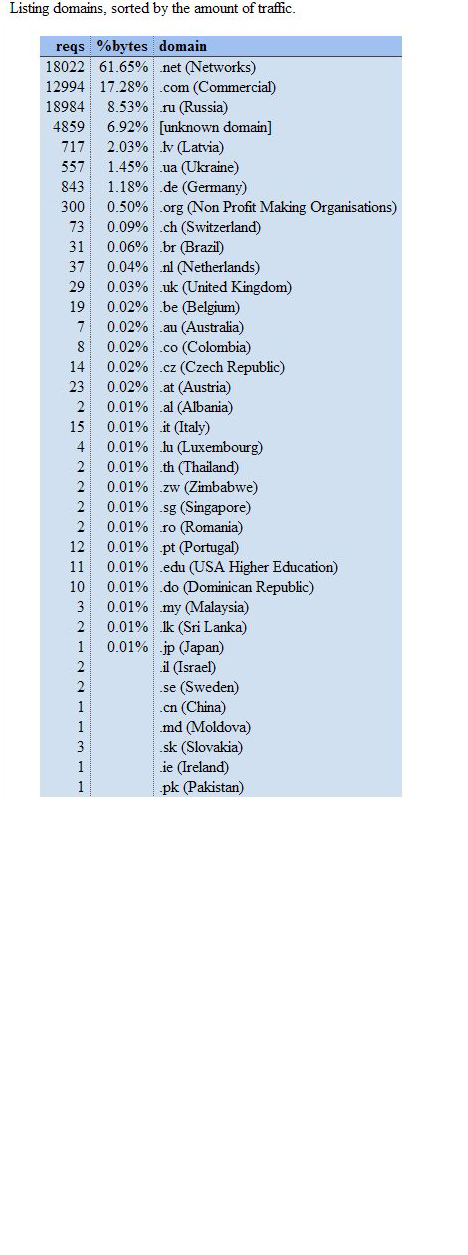
Visitors are coming in 2018 from more than 100 countries in this world (unknown domain are anonymizers, invalid ip's, Tor users etc..):
Listing domains, sorted by the amount of traffic.
| reqs | %bytes | domain |
|---|---|---|
| 32155 | 44.20% | [unknown domain] |
| 30557 | 23.27% | .com (Commercial) |
| 13447 | 18.78% | .net (Networks) |
| 5140 | 1.36% | .de (Germany) |
| 277 | 1.35% | .ca (Canada) |
| 220 | 1.34% | .us (United States) |
| 182 | 0.85% | .in (India) |
| 171 | 0.74% | .pl (Poland) |
| 223 | 0.71% | .org (Non Profit Making Organisations) |
| 268 | 0.69% | .it (Italy) |
| 101 | 0.58% | .uk (United Kingdom) |
| 1528 | 0.55% | .ru (Russia) |
| 83 | 0.48% | .edu (USA Higher Education) |
| 136 | 0.46% | .au (Australia) |
| 170 | 0.34% | .mx (Mexico) |
| 61 | 0.23% | .fr (France) |
| 60 | 0.18% | .se (Sweden) |
| 94 | 0.18% | .br (Brazil) |
| 51 | 0.17% | .ae (United Arab Emirates) |
| 37 | 0.14% | .ph (Philippines) |
| 29 | 0.13% | .ie (Ireland) |
| 29 | 0.12% | .za (South Africa) |
| 38 | 0.12% | .il (Israel) |
| 30 | 0.12% | .tr (Turkey) |
| 1019 | 0.11% | .cz (Czech Republic) |
| 25 | 0.11% | .sg (Singapore) |
| 44 | 0.10% | .th (Thailand) |
| 43 | 0.10% | .pt (Portugal) |
| 30 | 0.10% | .kz (Kazakhstan) |
| 101 | 0.10% | .at (Austria) |
| 142 | 0.09% | .nl (Netherlands) |
| 99 | 0.09% | .ch (Switzerland) |
| 11 | 0.09% | .gy (Guyana) |
| 19 | 0.08% | .id (Indonesia) |
| 32 | 0.08% | .fi (Finland) |
| 282 | 0.07% | .ua (Ukraine) |
| 23 | 0.07% | .be (Belgium) |
| 22 | 0.07% | .pk (Pakistan) |
| 30 | 0.06% | .no (Norway) |
| 20 | 0.06% | .arpa (Arpanet) |
| 329 | 0.06% | .tk (Tokelau) |
| 9 | 0.06% | .dk (Denmark) |
| 21 | 0.06% | .jp (Japan) |
| 26 | 0.06% | .lt (Lithuania) |
| 7 | 0.05% | .gov (USA Government) |
| 9 | 0.05% | .co (Colombia) |
| 11 | 0.05% | .lk (Sri Lanka) |
| 16 | 0.05% | .nz (New Zealand) |
| 10 | 0.05% | .ec (Ecuador) |
| 18 | 0.04% | .gr (Greece) |
| 29 | 0.04% | .hu (Hungary) |
| 6 | 0.04% | .bg (Bulgaria) |
| 7 | 0.04% | .vn (Vietnam) |
| 27 | 0.04% | .ro (Romania) |
| 10 | 0.04% | .my (Malaysia) |
| 6 | 0.03% | .ge (Georgia) |
| 14 | 0.03% | .es (Spain) |
| 3 | 0.03% | .pg (Papua New Guinea) |
| 72 | 0.03% | .hr (Croatia) |
| 5 | 0.03% | .gt (Guatemala) |
| 4 | 0.02% | .ke (Kenya) |
| 4 | 0.02% | .bh (Bahrain) |
| 3 | 0.02% | .jo (Jordan) |
| 3 | 0.02% | .zw (Zimbabwe) |
| 10 | 0.02% | .md (Moldova) |
| 4 | 0.02% | .bd (Bangladesh) |
| 4 | 0.02% | .kg (Kyrgyzstan) |
| 21 | 0.02% | .is (Iceland) |
| 3 | 0.02% | .cy (Cyprus) |
| 22 | 0.02% | .ly (Libya) |
| 16 | 0.02% | .ar (Argentina) |
| 7 | 0.02% | .tv (Tuvalu) |
| 105 | 0.02% | .cn (China) |
| 5 | 0.02% | .ir (Iran) |
| 6 | 0.02% | .om (Oman) |
| 7 | 0.02% | .ws (Samoa) |
| 3 | 0.02% | .bm (Bermuda) |
| 2 | 0.02% | .mil (USA Military) |
| 2 | 0.02% | .gh (Ghana) |
| 6 | 0.02% | .biz (Businesses) |
| 44 | 0.02% | .sk (Slovakia) |
| 3 | 0.02% | .am (Armenia) |
| 2 | 0.02% | .mk (Macedonia (Former Yugoslav Republic)) |
| 2 | 0.02% | .hn (Honduras) |
| 3 | 0.01% | .bn (Brunei Darussalam) |
| 4 | 0.01% | .cl (Chile) |
| 2 | 0.01% | .ba (Bosnia-Herzegovina) |
| 2 | 0.01% | .sa (Saudi Arabia) |
| 2 | 0.01% | .ni (Nicaragua) |
| 2 | 0.01% | .np (Nepal) |
| 1 | 0.01% | .cm (Cameroon) |
| 1 | 0.01% | .cr (Costa Rica) |
| 1 | 0.01% | .kr (South Korea) |
| 1 | 0.01% | .ky (Cayman Islands) |
| 1 | 0.01% | .info (Informational) |
| 1 | 0.01% | .tj (Tajikistan) |
| 1 | 0.01% | .lv (Latvia) |
| 1 | 0.01% | .ma (Morocco) |
| 1 | 0.01% | .uz (Uzbekistan) |
| 1 | 0.01% | .vi (Virgin Islands (USA)) |
| 1 | 0.01% | .pe (Peru) |
| 1 | 0.01% | .aw (Aruba) |
| 1 | 0.01% | .az (Azerbaijan) |
| 2 | 0.01% | .hk (Hong Kong) |
| 12 | .io (British Indian Ocean Territory) | |
| 22 | .by (Belarus) | |
| 7 | [unresolved numerical addresses] | |
| 3 | .do (Dominican Republic) | |
| 13 | .lu (Luxembourg) | |
| 2 | .ee (Estonia) | |
| 1 | .uy (Uruguay) | |
| 2 | .lb (Lebanon) | |
| 1 | .tw (Taiwan) | |
| 1 | .kh (Cambodia) | |
| 1 | .ps (Occupied Palestinian Territory) | |
| 1 | .ag (Antigua and Barbuda) | |
| 1 | .ci (Ivory Coast) | |
| 1 | .ml (Mali) | |
| 1 | .pm (Saint Pierre and Miquelon) | |
| 1 | .sh (Saint Helena) | |
| 1 | .bj (Benin) |
Average day of january (around 2000 page views, just for the Seo pages that report an average of 3 visitors per day for this site. And for Seos which are not really firm in primary school math this means 60.000 page views a month and nearly one million page views a year. )
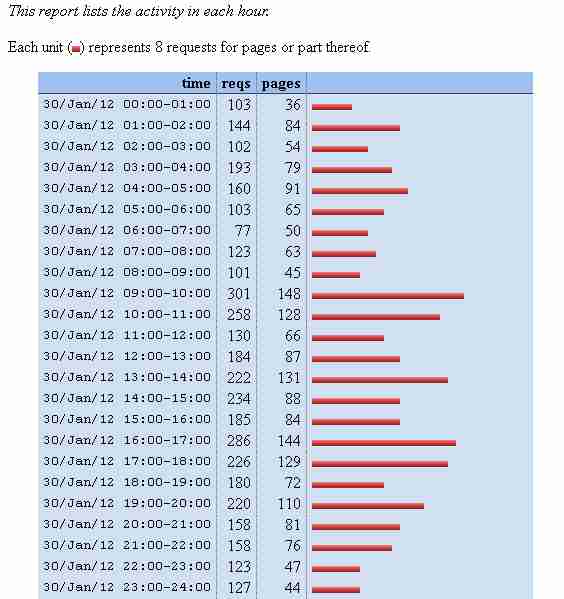
Pageviews over one full week (the peeks are due to new page uploads etc):
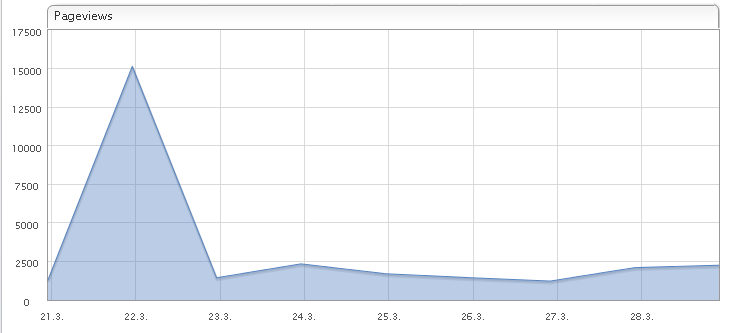
Preface: it is near to impossible to fake screen shots!
In January 2012 Google found one million backlinks to this site (Google.com 1.050 mio Google.de 1.070mio.
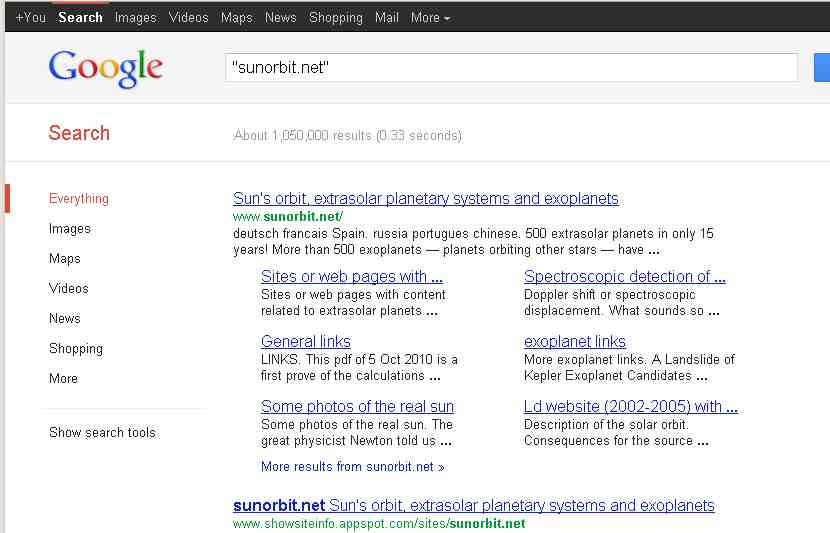
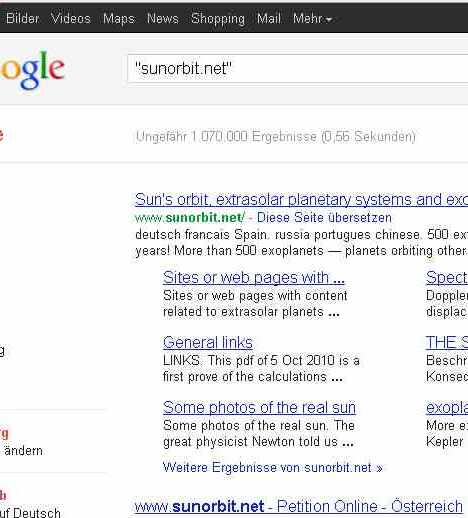
Normally this would reflect in a much higher ranking of this site. If you want to test it by yourself: search for "sunorbit.net" in quotes. You get a list of all pages on which sunorbit.net is mentioned. Don't wonder if all relevant lnks come on the last pages. Out of some strange reason Google likes in this case to reverse its sort algorithm. And if you want to see the links that Google doesn't show use any other (independant!) search engine. Fortunately there are still some few that don't depend on Google's results.).
And since quite a while Google likes to play the dirty game of showing on the first page of the search results a much lower results count than on the 4th or 5ths page. This can be sometimes as low as 1/10 of the real search results, so that innocent Seo's which only look on the first page get a totally wrong impression. These two screenshots were taken just one second apart on 2.of April 2012.
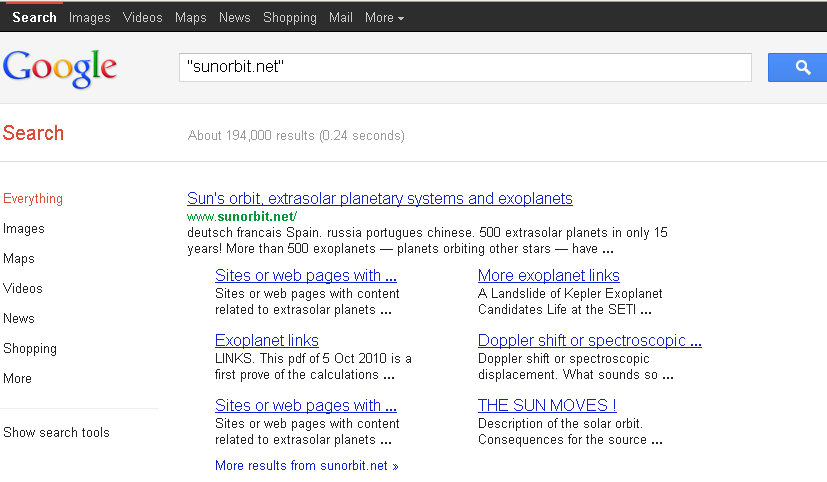
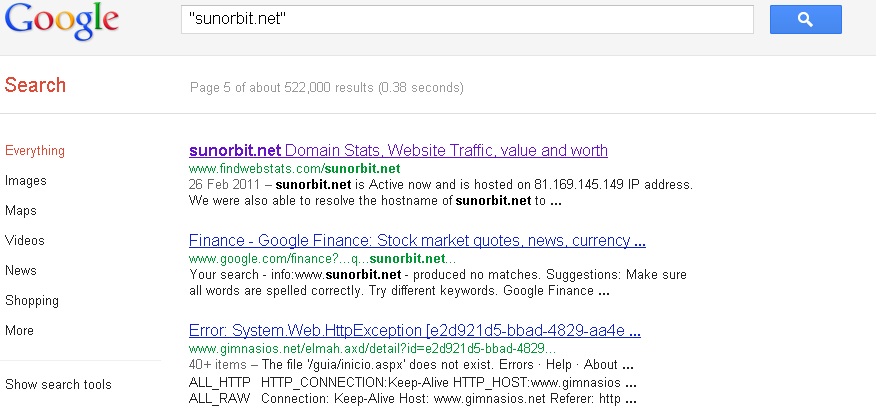
This is what Google showed on 8. of April 2012: who is right , Google.com or Google.de? Or none of them? .
(Please note: these 2 screenshots were taken some days after the other screenshots on this page were published. As you can see Google was right in the transition phase of switching back to a normal sort order - but the links of blekko.com below Google has still not found (2 weeks later). While US-Google.com already shows the links almost in the normal sort order - most important links first - Google.de still has the reverse sort order: most irrelevant links first.
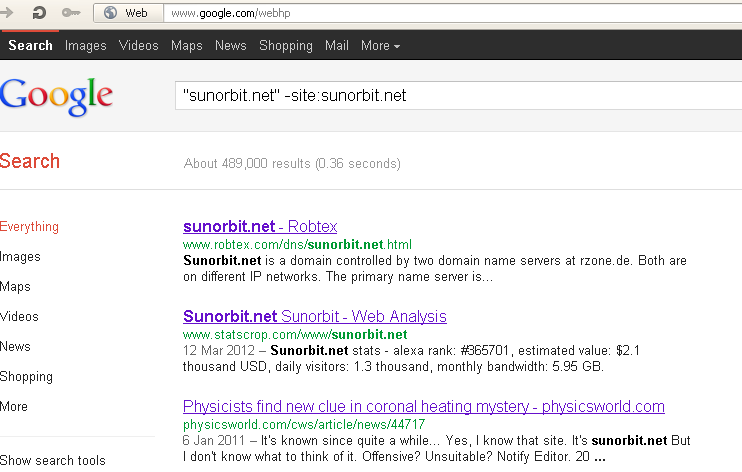
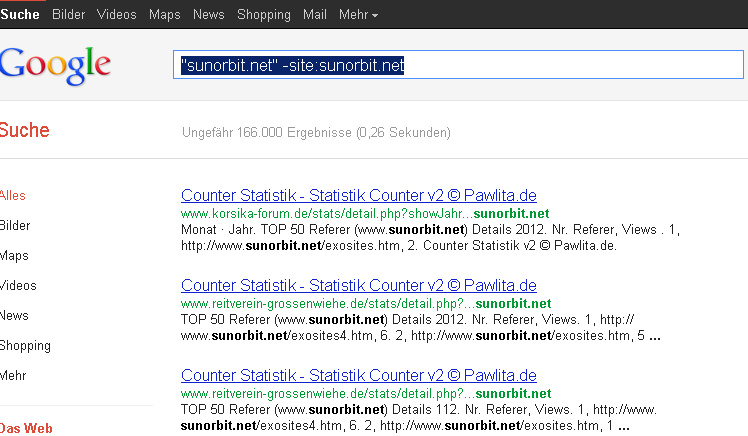
If you want to test other search engines etc there are special sites in the net, for instance http://push2check.com/sunorbit.net. where you can get this information. Test for instance the yahoo dir button:
If you want to see links that Google doesn't shows use for example blekko.com - a rather small and unknown search engine, with many links that you won't find in Google Is Google such a bad search engine that they really can't compete with blekko or does Google hides intenionally these links??? And these are not all. I found some really important ones on other search engines! :

Another one - maybe these results are not important - but you won't find these results in Google, why?:
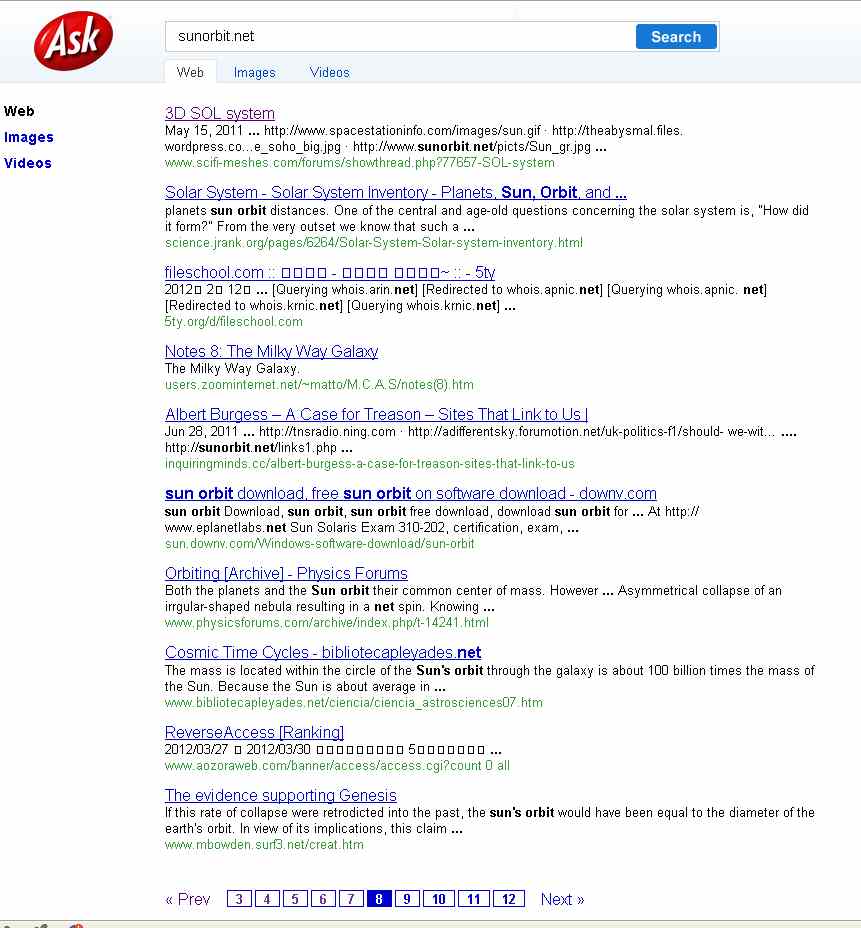
These 2 links Google is absolutely unable to find in the normal search results: Is Google really not able to compete with blekko??
Some more links, so that Google can manually integrate them in their search results (I will upload them by and by so that everyone can follow the integration in Google's search results - till it gets too embarrasing for Google):

and also the link above from blekko.com Google knows if you explicitely ask for "sunorbit.net" + abovetopsecret.com (but does not show it to you in the normal search results. Why? Does Google has something to hide?):
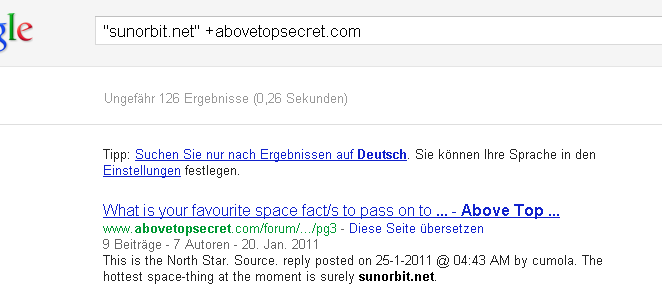
19.4.12: Congratulations! Google.de found this one and lists it on one of the last pages of the search results! So the following is history: Another one, which will Google only show you if you know it already, same as the link above. It should be clear to anybody that this is not the definition of a search engine! I don't need a search engine to find the links I know! Insert "sunorbit.net" + zeit.de in the search box, then you get this:

and even these excite search results reveal some interesting results, which Google does not show :
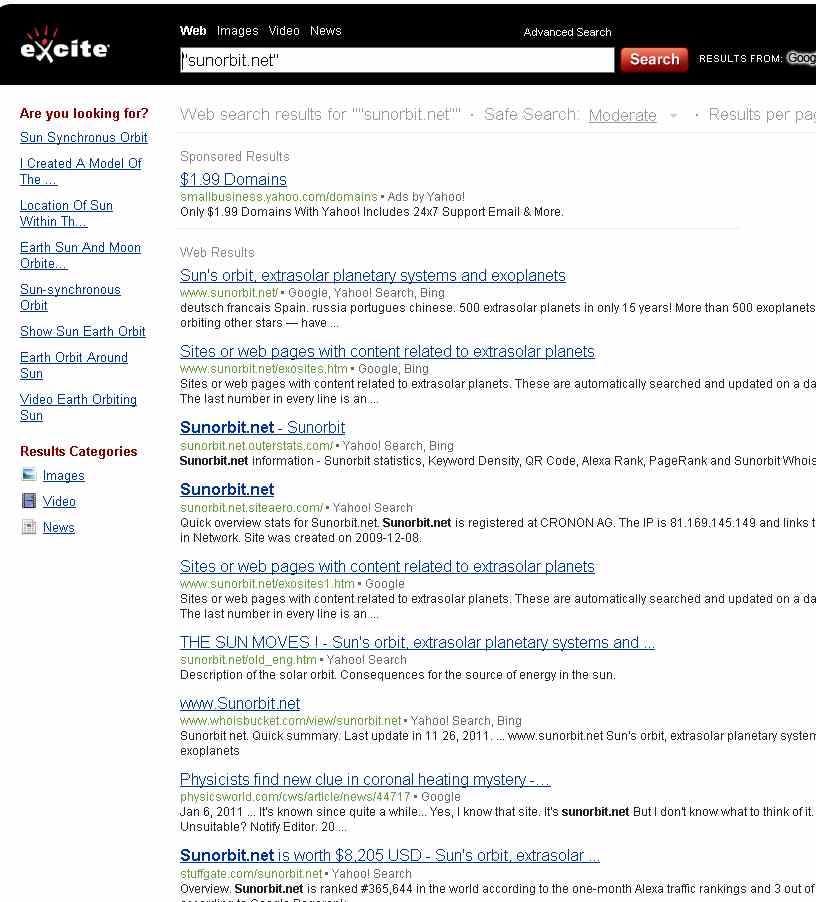
Btw, some of the links above Google found after publishing these results....
On 4th of April 2012 Bing and Yahoo for the first time did sent more visitors than all Google's world wide combined - surely a sensational fact if you know their respective market share. With steadily increasing visitor count !
Just for the record, the well known search engine ixquick has less backlinks than this site, only as an example (and in this context you should know that ixquick - as any other site with that many backlinks - has Google pagerank 7 of 10, but sunorbit.net has got only Google pagerank 3 of 10! Strange, isn't it? If you want to test it by yourself go for example here: ) :
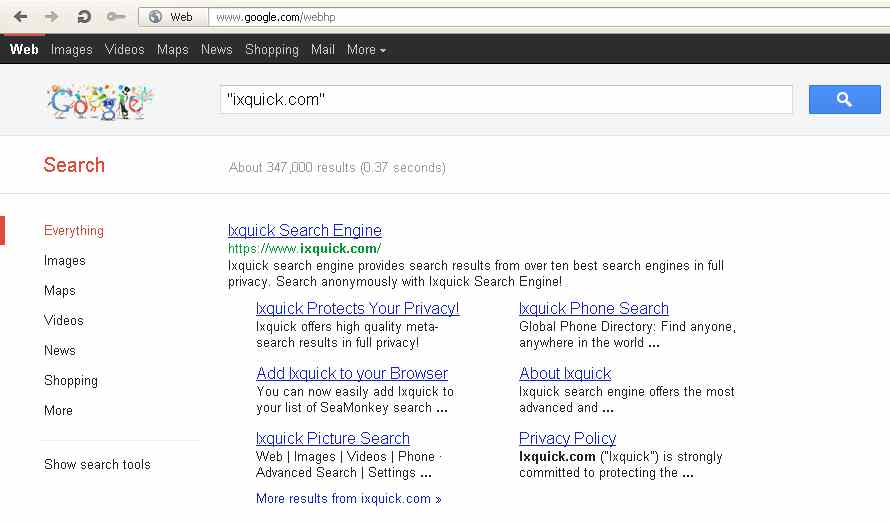
Another example, this time Google pagerank 6 and also lower (much much lower ! nearly 1/20th) backlink count:

No more:(see text below) Download the program here: gravity.zip download .dat file (read here how this program was developed)
Please be aware that this is no Windows-program! 1990/91 there existed no Windows(or Windows 3.0 which was useful for nothing)! It may function under the Dos-prompt of Windows, but no guarantee given! Be aware that even under Dos there is no guarantee that the program works! When this program was written, the newest VGA-cards were WD Paradise, ET3000 and OAK-cards! There are even some functions which for sure won't work with todays DOS/Windows, because the function-calls have changed (eg the write-comand.) I never reworked the program because I consider it a document.
Please use your own data for the .dat file. The .dat file changed a lot, because very different simulations have been accomplished with the program.
Why the program is no more downloadable?
The program was written in the 1980ths. In the 80ths there simply was no graphical OS (the first versions of Windows in the beginning 90ths were simply crap). The program was written for MS-Dos, for which a good compiler existed. But MS-Dos had no graphical standard defined. So you needed special drivers id you wanted something else than the standard 320x240 resolution of the color cards. These drivers have long disapeared and do no more work under modern OS's. So in 2014 I was tired of the many complains.....
Change in old_eng.htm: On 13.April 2010 I took some of the harsh formulations out of old_eng.htm - without changing the content I hope. In foreign languages it is not always easy to judge the exact meaning of an expression. So it's easy to cross the borders to insulting expressions where you only wanted to make a yoke.
Since the very beginning of this site I have a (in numbers 1) visitor from the wonderfull seychelles: Greetings!
2.8.2010 uploaded the already 2002 announced additional arguments that solar energy results out of the here described forces: global_warming.htm or klimawandel.htm(german)
US-Army got some smart guys. They visit these pages nearly every other day and note every little change ... But also all important US-Universities have visted this site and all important german Universities. And even german military.
This site has a 2:1 relationship of professionals to private users: on weekends the visitor count is much lower than on weekdays .
New site: http://www.exoplanets.4ju.org (or http://www.exoplanets.4uj.org)
New site: http://www.extrasolar-planets.4ju.org (or http://www.extrasolar-planets.4uj.org)
New site: http://www.secondearth.eu
Enlarged the font of some pages, because some people told me they had problems with the eyes and the new 1920x1200 screens.
Most of the (important) links on the links page were found with the oldest technique of the net, which was possible right after the invention of the WEB by CERN in 1991-1994 (Midas,Viola, later Mosaic) and before there existed any search engine: by following links. Some few (1-2) were found after one year or two (!) by googling. This is in the first place due to the ever increasing comercialication of the net (and the obvious and often complained low ranking of science pages in Google). Some I could only find with the aid of the ExositesCrawler. Seems it's high time for a european search engine with an adequate ranking for science pages!
I note since quite some time from my server log files that many internet users surf with very antiquated settings: the browser cache settings of many visitors to this site are still set as usual in modem connection times, which means a big cache. This is antiquated since most internet surfers today are connected via DSL and it means today only a minimal longer load time of html pages if the cache is set to zero. On the negative side it means that many of the visitors of my sites don't see actual pages but pages which are at least one month old if not older. So half of the net (the most actual pages) may pass unseen by many surfers.
As many of you have noted this site can't win any prices what concerns design. Design is not my concern and the site surely looks like that. But the site is designed for speed. Because there are still people with slow connections out there.
Finally....
Apologies for using so many bracketed sentences, but footnotes are not usual in the net
My grandfather once told me that there are two kinds of people:
Those who do the work and those who take the credit.
He told me to try to be in the first group; there was
much less competition.
Indira Gandhi